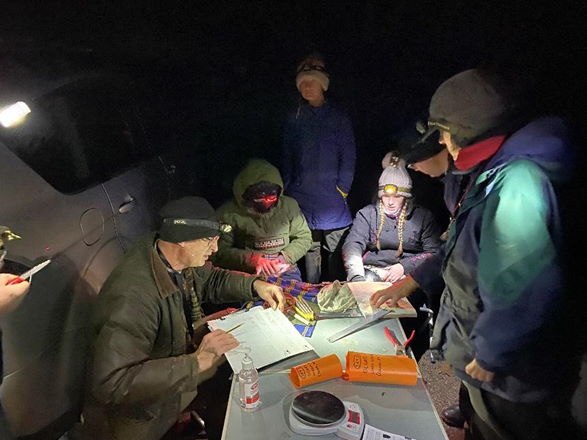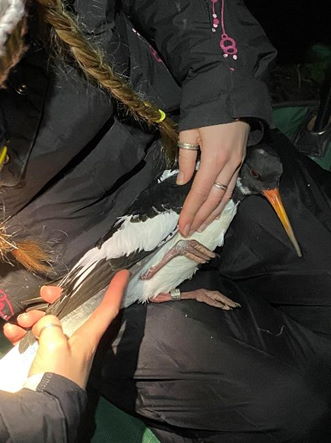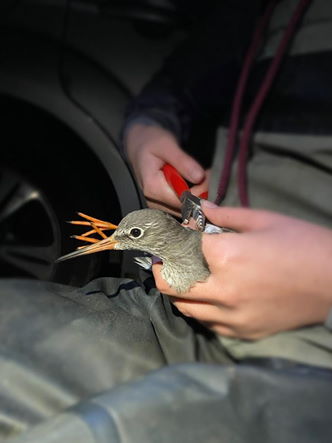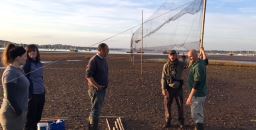High Tide 4.10m @ 19:23, Sunset 16:10, Rendezvous 14:45
The team gathered on a breezy Sunday afternoon at RSPB Exminster marshes to set a total of 13 mist nets in three separate lines, in preparation for an evening wader mist net catch. The site has a series of fields with newly established flooded pools that the waders come into when it is high tide out on the estuary, and it was across and around one of these pools the nets were set. As forecast, the wind died down during setting, and it was almost perfect conditions for the evening. All the nets were up with plenty of time to spare, and the team went back to the base to wait for dusk.
The first net round was just as darkness was falling. Whilst out on this first net check, we set out curlew and lapwing decoys and started playing wader calls to encourage the birds into the pools. If you do this too early, birds may see the nets and decide to roost elsewhere, so we had to hold off until darkness to do so. We caught a couple birds even before it was dark, a redshank and a godwit that had come into the pools early.
When it was completely dark, the first proper net round was very productive, with good numbers of birds caught in every net, and a nice variety of species too. It’s always exciting doing the first net round, you never know what you might get, and the dark adds an element of surprise to what you’ve caught until you’re extracting the birds. With a good team of experienced extractors, the birds were quickly out of the nets, and the other members of the team all helped with organising which bird went in which bag and carrying all the birds safely back to base.
Once the birds were brought back to the ringing base, they were put in fabric keeping cages to keep them calm. One by one, birds are taken out and brought over to the processing team, where they are ringed, their age and sex determined, and biometric measurements taken, including wing length, bill length, tarsus length and weight. We also colour ring certain species (dunlin and curlew on this catch) to increase the chance of them being re-sighted, providing more valuable scientific data. The colour ringed birds then get their photos taken, and after all that is finished, they are taken for release back out onto the marshes.
 Some of the team processing godwits © Robbie Phillips
Some of the team processing godwits © Robbie Phillips  An Oystercatcher having its wing length measured © Robbie Phillips
An Oystercatcher having its wing length measured © Robbie Phillips
The team had a good mix of experienced people and trainees, and the pace of the evening was a great learning environment for people who had not worked with waders much before, giving lots of people chances to handle species they weren’t familiar with previously. Mist netting processing is different to cannon netting; the person who rings the bird also gets to take all the biometric measurements, which is great for training up newer team members on the full process from start to finish. Everyone learned a lot and all seemed to thoroughly enjoy the evening.
 Redshank about to be ringed © Amelia Corvin-CzarnodolskiWe had a few more productive net rounds after the main one, but the catch tailed off quite quickly once the tide started to drop and birds moved off the pools back to the estuary. Which was good in a way as it meant the team got a (relatively) early night after being on the marsh for hours. We were all packed up by 22:00 and everyone headed home happy.
Redshank about to be ringed © Amelia Corvin-CzarnodolskiWe had a few more productive net rounds after the main one, but the catch tailed off quite quickly once the tide started to drop and birds moved off the pools back to the estuary. Which was good in a way as it meant the team got a (relatively) early night after being on the marsh for hours. We were all packed up by 22:00 and everyone headed home happy.
The catch ended up being 41 wading birds of 7 species (and 5 starlings which flew into the nets whilst setting). The species caught were dunlin, redshank, bar-tailed godwit, black-tailed godwit, curlew, lapwing and oystercatcher. That’s always one of the pros of mist netting, you can get quite a wide range of species. A further 16 individual birds got colour rings, which is a brilliant result as that was one of the main aims of the catch. The colour ring sightings can provide some amazing data, so it will be exciting to see what sightings we may get of these birds in the future. Overall, it was a brilliant success of an evening, with great training experiences for newer group members, good scientific value from a small catch with the colour ringing, and a fun evening for all involved. I will definitely be looking forward to helping out again with the next session!
Ellie Ness - team member
